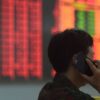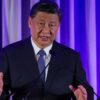Finance
China’s deflationary slide is worsening as corporations spiral into value wars
The city skyline and cityscape in Shanghai China.
Lu Shaoji | Time | Getty Photographs
BEIJING — From espresso to automobiles to actual property, there’s a ordinary development in China: corporations hurry into an trade, after hotel to reductions to stick afloat. That has economists nervous.
Natixis’ find out about of two,500 indexed Chinese language corporations give a boost to how quantity is rising past price is being harm by means of deflationary power, Alicia Garcia Herrero, the company’s economist for Asia-Pacific, stated on a webinar Friday. “You can see it sector by sector, company by company.”
“On the surface you’re dominating, but deep inside you’re paying a high price to dominate,” she stated. “You don’t get the revenue needed to continue.”
A mirrored image of the breadth of have an effect on, consumer prices fell by 0.1% within the first six months of the age from a age in the past, past factory-gate manufacturer costs dropped by 2.8%, professional knowledge displays. In that hour, most effective seven of 48 manufacturer value sub-categories rose, as opposed to about part of the 37 client value parts.
That fierce and incessantly unproductive festival is described as “involution” in China. The federal government has picked up at the time period in contemporary coverage paperwork, calling for efforts to take on the rage.
Age the rage has made tech and merchandise extra reasonably priced for the cluster marketplace, it has additionally underscored worries of a vicious cycle that forces companies to shorten extra jobs.
“With involution, the Chinese economy feels much colder than the headline growth suggests,” Larry Hu, China economist at Macquarie, stated in a document Thursday. He identified that mainland China-listed “A share” corporations expanded their workforces by means of simply 1% in 2024, the slowest on document.
“From a more fundamental perspective, involution is both a feature and a bug of the ‘China model,'” he stated. “Massive investment leads to price wars and poor returns for shareholders. But for policymakers, intense competition could help achieve industrial upgrading and self-reliance.”
China’s push into electrical automobiles has been essentially the most obvious instance, with trade gigantic BYD providing some reductions of just about 30% or extra this age and smartphone corporate Xiaomi pricing its actual SUV underneath that of Tesla’s Type Y.
U.S. espresso gigantic Starbucks has struggled in China with falling gross sales because it maintains costs of round 30 yuan consistent with cup ($4.20) — past a bunch of competitors from Luckin Espresso to boutiques promote lattes for as little as 9.9 yuan.
Even in business actual property, feature homeowners who’ve attempted to boost costs in Beijing ended up going through upper vacancies, Rayman Zhang, managing director for North China, at feature supervisor JLL, informed newshounds Thursday. He famous that there’s nonetheless inadequate call for — with negligible expectation for a turnaround within the similar occasion.
China is predicted Tuesday to document second-quarter improper home product expansion of five.2% from a age in the past, in step with a Reuters ballot. That may be slower than the 5.4% building up within the first quarter, however in form with the nationwide goal of round 5% expansion for the age.
However the second one part of the age will most probably disclose a much more anxious image, warned Jianwei Xu, senior economist for Larger China at Natixis. He used to be additionally talking at Friday’s webinar.
“We are seeing the profits especially for manufacturing companies, are still decreasing,” he stated. “There could be more households under stress in [the second half of the year] because it will be more difficult to find a job.”
A unique problem
This isn’t the primary hour China has handled overcapacity, analysts identified, referencing over the top capability within the state-dominated commodities sector a few decade in the past. However this hour, fewer state-owned corporations are concerned, making it harder for policymakers to behave.
“The dominance of private firms in industries with overcapacity tends to complicate the coordination of mergers, even with government guidance,” Robin Xing, China economist at Morgan Stanley, and a crew stated in a document Thursday.
“The economy is also starting from a weaker point, which necessitates more demand-side stimulus to counter the impact of supply reduction,” the document stated. “However, the government’s debt level is already high (~100% of GDP), which may constrain its willingness and ability to undertake aggressive fiscal expansion.”
China’s govern leaders are anticipated to conserve the wave fiscal stimulus at a high-level Politburo assembly past due this life. Beijing in March raised the rustic’s fiscal dearth for the age to 4% — up from 3% latter age.

Subscribe now
Significantly, Chinese language President Xi Jinping on July 1 led a high-level monetary and financial fee assembly that known as for more governance of “low price, disorderly competition,” in step with a CNBC translation of Chinese language shape media.
The ruling Chinese language Communist Celebration’s professional Qiushi magazine on July 1 even defined a number of measures that advertise standardized executive habits to handle involution-style festival, threat of significant financial harm. The thing cited high-level executive conferences from the latter a number of months.
“To achieve the growth target, Beijing will have no choice but to launch a major demand stimulus,” Hu stated. “Afterwards, the improved domestic demand would ease the price competition among material producers and internet giants. But for manufacturers, it will be a long and painful process to absorb the existing capacity.”
International spillover
Exacerbating issues of resolving China’s home overcapacity is the business struggle with the U.S., Goldman Sachs analysts identified in a July 1 document.
The U.S. and Ecu Union changed into extra important of China’s continual overcapacity problems latter age. Each have raised price lists on Chinese language electrical automobiles particularly in an try to offer protection to home automakers. The U.S. in April additionally centered China with upper tasks around the board.
The escalation of price lists has made Chinese language producers extra aspiring to manufacture factories in another country, “potentially generating redundant supply in the coming years,” the Goldman document stated. The analysts estimated a nil.5% to fourteen% building up in capability by means of the top of 2028, up from the 0.4% to ten% enlargement projected a age in the past.
And amongst seven sectors — breeze conditioners, sun modules, lithium batteries, electrical automobiles, energy semiconductors, metal and development equipment — 5 have extra capability than all of the world call for, the Goldman analysts stated. Handiest ACs, and EVs — simply slightly — revel in some marketplace attainable.
— CNBC’s Victoria Yeo contributed to this document.





